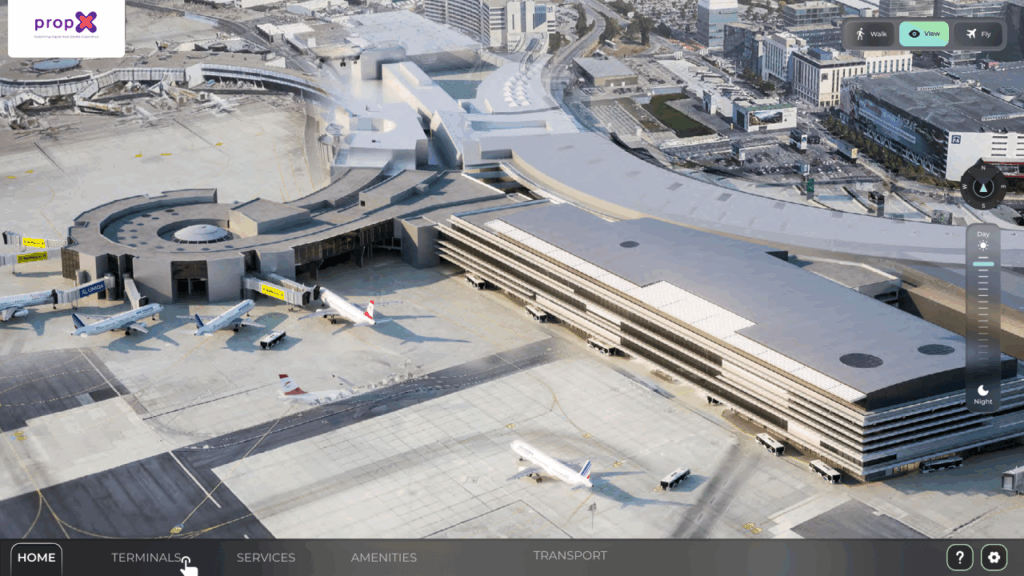This article explores the utilization of Augmented Reality (AR) and Mixed Reality (MR) technologies in airport settings to enhance the performance of Digital Twins of Airport City spaces.
A Sneak Peek into the Known
Digital Twins are virtual representations of physical assets or systems that are used to simulate, monitor and optimise their performance in real-time. Digital Twins use data from sensors, Internet of Things (IoT) devices, and artificial intelligence (AI) to create an interactive digital environment that mirrors the physical one.
One of the emerging applications of digital twins is in the aviation sector, where airports benefit to a great extent from creating digital replicas of their infrastructure, operations and services. Airports are complex systems involving multiple stakeholders, and 3d technologies that need to be coordinated and integrated efficiently.
The Challenge of Airport Complexity
Airports are extremely complex systems with hundreds of processes running in parallel and interacting with each other. These processes are largely computerised, but often operate in silos, without integration or coordination. This creates confusion and inefficiency for airport operators, airlines and passengers, who often face delays and a lack of information.
The challenges are huge: Airports have to cope with increasing passenger demand, security threats, environmental regulations, operating costs and, most importantly, customer satisfaction.
In a perfect world, the use of Digital Twins would enable airports to gain a holistic view of their current and future scenarios, identify potential bottlenecks and implement data-driven rather than gut-based solutions.
The Role of Augmented and Mixed Reality in Airport Digital Twins
AR and MR are technologies that overlay digital information or objects onto the real-world environment or create a hybrid environment that combines both physical and digital elements. What is important to know: AR and MR need the digital twin as a base layer to work at all, especially when it comes to geo-specific applications in the airport city space.
AR and MR apps enhance the capabilities of airport digital twins in various domains such as construction monitoring, maintenance and repairs, safety training, passenger navigation, stakeholder collaboration, visualization of future developments, and space optimization:
Construction Monitoring
AR/MR overlays the BIM model onto the real-world construction site. This allows project managers, engineers, and architects to visually compare the digital plan with the actual construction progress. This helps in identifying discrepancies early, mitigating potential risks, and ensuring adherence to the original design plan.
NOTE: Without a digital twin base layer, meaningful geo-specific and live-view AR/MR simulations are not possible.
Maintenance and Repairs
Technicians use their AR/MR headsets (e.g. Microsoft Hololens 2 or Apple Vision Pro) or tabloids to visualize the complex networks of electrical and HVAC systems within the airport’s structure, overlaid on the physical view of the building. This allows them to “see-through” walls and floors, providing a clear understanding of the system layout and pinpointing problem areas, thus facilitating timely and accurate repairs.
NOTE: Having a digital twin base layer is essential for accurate AR solutions when working on-site. Without it, the accuracy of the AR may be compromised.
Safety Training
AR/MR technologies can be used to create realistic safety training scenarios for airport staff. For example, emergency evacuation routes can be visualized in real-time, fire drills can be practised without causing disruption, and understanding of complex systems is improved through interactive learning experiences.
Passenger Navigation
AR-enabled mobile applications overlay directional indicators, facility locations, gate changes, or flight status updates onto the live view of passengers’ mobile devices. This could greatly enhance the passenger experience, making navigation through the large airport premises easier and more efficient.
Stakeholder Collaboration
MR could enable multiple stakeholders to collaborate in a shared, interactive 3D visualization of the airport’s BIM model, regardless of their geographical location. This allows for more effective collaboration between diverse teams, including designers, engineers, contractors, and airport management.
Visualization of Future Developments

AR/MR tech is already used to visualize future expansion plans or renovations in the existing airport environment. This helps stakeholders to better understand the proposed changes, and facilitate informed decision-making.
Space Optimization

AR/MR helps in analyzing passenger flows and optimizing spaces for better movement. By understanding how passengers move through and interact with the airport space, the airport’s management is able to optimize layouts to improve passenger experiences and operational efficiency.
Conclusion
The use of AR and MR technologies greatly benefits airports by providing a more interactive and immersive experience through virtual representations of the physical airport. These technologies have many useful applications, leading to a predicted rapid growth in the global airport digital twin market:
The market is expected to expand at a CAGR of 42.1% from 2022 to 2027, reaching USD 4.5 billion by 2027. Additionally, the airport digital twin market is expected to converge with metaverse technologies, integrate with smart city initiatives, and apply to outdoor 3D reality modelling. Airports can confidently become more sustainable and smart hubs for the future, with the help of Augmented and Mixed Reality!



